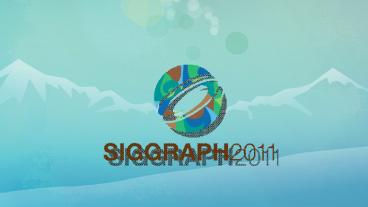Image-Guided Weathering: A New Approach Applied to Flow Phenomena - PowerPoint PPT Presentation
1 / 36
Title:
Image-Guided Weathering: A New Approach Applied to Flow Phenomena
Description:
* * Notice how the stain adapts to different scenarios: sources of different size, targets of different geometry and background color, * * * * These timings ... – PowerPoint PPT presentation
Number of Views:103
Avg rating:3.0/5.0
Title: Image-Guided Weathering: A New Approach Applied to Flow Phenomena
1
(No Transcript)
2
Image-Guided WeatheringA New Approach Applied
to Flow Phenomena
C. Bosch1, P. Y. Laffont, H. Rushmeier, J.
Dorsey, G. Drettakis Yale University
REVES/INRIA Sophia Antipolis 1 Currently at
ViRVIG, University of Girona
3
Aging and Weathering
- Essential for modeling urban environments
- Governed by physical, chemical and biological
processes
4
Flow effects
- Particularly complex
- Flow over the scene (global effect)
- Material properties (local effect)
5
Aging and Weathering in CG
- Physically-based simulation
- Difficult to get the desired effect
- Texture synthesis
- Restricted by input information
- Global effects particularly hard
6
Motivation
- Physically-based simulation
- More flexible, allows global effects
- Two main difficulties
- Choosing appropriate parameters to achieve a
given effect - Obtaining realistic visual detail
7
Image-Guided Weathering
- Use images to guide simulation
- Flow stains as a representative case
Exemplar
New simulation
8
Overview (I)
- Extract data from exemplars
- Color information
- Simulation parameters
- High frequency details
Si 1.301 rt 0.252 kS 0.0201 at
0.404 kD 0.0807 T 803 ka,t 0.021
Exemplar
Data
9
Overview (II)
- Simulate new effects on scenes
Si 1.301 rt 0.252 kS 0.0201 at
0.404 kD 0.0807 T 803 ka,t 0.021
Data
10
Related Work
- Simulation
- Phenomenon-specific Merillou08
- Flow stains Dorsey96 Chen05 Endo10
- Capture-and-transfer (synthesis)
- Single image Wang06 Xue08
- Acquisition systems Gu06 Mertens06 Sun07
Lu07 - Inverse procedural textures Bourque04
Lefebvre00
11
Flow model
- Particle-based simulation Dorsey96
- Absorption, solubility and deposition
- Stain concentration maps
- Parameters
- Particles mass (m), Si
- Stain material kS, kD
- Target materials a, ka, roughness (r)
- Simulation time (t), particle rate (N)
12
Extracting Stains
- Based on Appearance Manifolds Wang06
Exemplar
13
Parameter Fitting
- Degree map Stain concentration map
Proxy geometry
(Levenberg-Marquardt) Lourakis04
14
Improving Fitting
- Stain distribution along the source
- Accumulate degree from bottom to top
15
Improving Fitting (II)
- Flow deflection along the target
- Compute local degree distribution (vector field)
16
Parameter Fitting (II)
17
Fitting Results (w/o vector field)
Using source distribution
Exemplar
Degree Map
Simulation
18
Fitting Results (w/o vector field)
Exemplar
Degree Map
Simulation
19
Fitting Results (w/ vector field)
Exemplar
w/o vfield
Degree Map
Simulation
20
Fitting Results (w/ vector field)
Exemplar
Degree Map
Simulation
21
Fitting Results (w/ vector field)
Exemplar
Degree Map
Simulation
22
Fitting Results (Complex Targets)
Exemplar
Degree Map
Simulation
23
Stain Detail
- Simulation lacks spatial variations
(high-frequency detail)
Degree Map
Simulation
Exemplar
24
Detail Maps
- Extract detail by image difference
- Use guided texture synthesis Lefebvre05
- Detail maps will modify stain adhesion
Detail Map
Degree Map
Simulation
Difference
25
Simulating New Stains
- Link data to stain sources and targets
- Parameters, detail maps, color
- Use 1D texture synthesis for distributions
- Run flow simulation
- Flow deflected by target geometry ( disp. map)
26
Color Transfer
- Transfer stain color from input image
- Background mixed with stain everywhere
- Non-linear relationship between color and degree
- Use per-pixel warping
27
Results
28
Results (II)
29
Results (III)
30
Results (IV)
31
Performance
- Preprocessing
- Degree map 1-3 minutes
- Fitting 30-60 minutes (500 iter., 256x512)
- Detail synthesis 1-2 minutes (1024x1024)
- Final simulation
- Stain simulation 2-5 minutes/stain
- Color warping 5-8 seconds/stain (1024x1024)
32
Limitations
- Good extraction from background
- Fitting Not true physical estimations
- Detail maps Depend on appropriate fit
- Computation time
33
Conclusions
- New approach to acquire simulation data from
photographs - Solves parameter estimation from images
- Combines simulation with data-driven methods
- Appearance manifold, texture synthesis,
- Fills the gap between data-driven and simulation
- ? Easy to use
- ? Natural variations (including global effects)
34
Future work
- Extend to other weathering phenomena
- Deal with large scale scenes
- Fast simulation, global effects,
35
Acknowledgements
- Visiting grant U.Girona
- ANR project (ANR-06-MDCA-004-01)
- ERCIM Alain Bensoussan Fellowship
- Autodesk (Maya/MentalRay)
- Coding help Li-Ying, Su Xue
- Scene treatment S. Close and F. Andrade-Cabral
36
- Thank you































